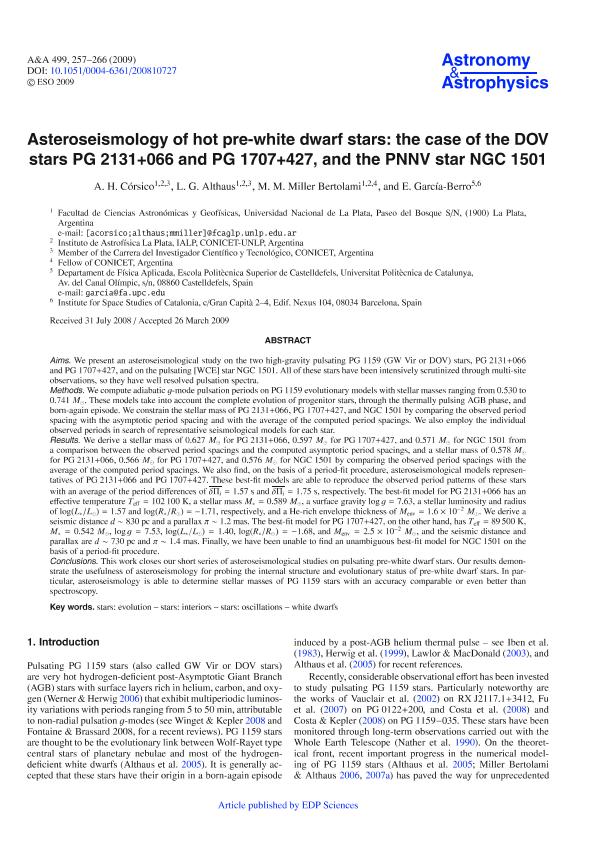Mostrar el registro sencillo del ítem
dc.contributor.author
Corsico, Alejandro Hugo

dc.contributor.author
Althaus, Leandro Gabriel

dc.contributor.author
Miller Bertolami, Marcelo Miguel

dc.contributor.author
García Berro, Enrique

dc.date.available
2018-04-23T14:45:45Z
dc.date.issued
2009-05
dc.identifier.citation
Corsico, Alejandro Hugo; Althaus, Leandro Gabriel; Miller Bertolami, Marcelo Miguel; García Berro, Enrique; Asteroseismology of hot pre-white dwarf stars: the case of the DOV stars PG 2131+066 and PG 1707+427, and the PNNV star NGC 1501; EDP Sciences; Astronomy and Astrophysics; 499; 1; 5-2009; 257-266
dc.identifier.issn
0004-6361
dc.identifier.uri
http://hdl.handle.net/11336/42991
dc.description.abstract
Aims. We present an asteroseismological study on the two high-gravity pulsating PG 1159 (GW Vir or DOV) stars, PG 2131+066 and PG 1707+427, and on the pulsating [WCE] star NGC 1501. All of these stars have been intensively scrutinized through multi-site observations, so they have well resolved pulsation spectra. Methods. We compute adiabatic g-mode pulsation periods on PG 1159 evolutionary models with stellar masses ranging from 0.530 to 0.741 M. These models take into account the complete evolution of progenitor stars, through the thermally pulsing AGB phase, and born-again episode. We constrain the stellar mass of PG 2131+066, PG 1707+427, and NGC 1501 by comparing the observed period spacing with the asymptotic period spacing and with the average of the computed period spacings. We also employ the individual observed periods in search of representative seismological models for each star. Results. We derive a stellar mass of 0.627 M for PG 2131+066, 0.597 M for PG 1707+427, and 0.571 M for NGC 1501 from a comparison between the observed period spacings and the computed asymptotic period spacings, and a stellar mass of 0.578 M for PG 2131+066, 0.566 M for PG 1707+427, and 0.576 M for NGC 1501 by comparing the observed period spacings with the average of the computed period spacings. We also find, on the basis of a period-fit procedure, asteroseismological models representatives of PG 2131+066 and PG 1707+427. These best-fit models are able to reproduce the observed period patterns of these stars with an average of the period differences of δΠi = 1.57 s and δΠi = 1.75 s, respectively. The best-fit model for PG 2131+066 has an effective temperature Teff = 102 100 K, a stellar mass M∗ = 0.589 M, a surface gravity log g = 7.63, a stellar luminosity and radius of log(L∗/L) = 1.57 and log(R∗/R) = −1.71, respectively, and a He-rich envelope thickness of Menv = 1.6 × 10−2 M. We derive a seismic distance d ∼ 830 pc and a parallax π ∼ 1.2 mas. The best-fit model for PG 1707+427, on the other hand, has Teff = 89 500 K, M∗ = 0.542 M, log g = 7.53, log(L∗/L) = 1.40, log(R∗/R) = −1.68, and Menv = 2.5 × 10−2 M, and the seismic distance and parallax are d ∼ 730 pc and π ∼ 1.4 mas. Finally, we have been unable to find an unambiguous best-fit model for NGC 1501 on the basis of a period-fit procedure. Conclusions. This work closes our short series of asteroseismological studies on pulsating pre-white dwarf stars. Our results demonstrate the usefulness of asteroseismology for probing the internal structure and evolutionary status of pre-white dwarf stars. In particular, asteroseismology is able to determine stellar masses of PG 1159 stars with an accuracy comparable or even better than spectroscopy.
dc.format
application/pdf
dc.language.iso
eng
dc.publisher
EDP Sciences

dc.rights
info:eu-repo/semantics/openAccess
dc.rights.uri
https://creativecommons.org/licenses/by-nc-sa/2.5/ar/
dc.subject
Evolution of Stars
dc.subject
Interior Stars
dc.subject
Oscillations
dc.subject
White Dwarfs
dc.subject.classification
Astronomía

dc.subject.classification
Ciencias Físicas

dc.subject.classification
CIENCIAS NATURALES Y EXACTAS

dc.subject.classification
Astronomía

dc.subject.classification
Ciencias Físicas

dc.subject.classification
CIENCIAS NATURALES Y EXACTAS

dc.title
Asteroseismology of hot pre-white dwarf stars: the case of the DOV stars PG 2131+066 and PG 1707+427, and the PNNV star NGC 1501
dc.type
info:eu-repo/semantics/article
dc.type
info:ar-repo/semantics/artículo
dc.type
info:eu-repo/semantics/publishedVersion
dc.date.updated
2018-04-19T18:32:41Z
dc.journal.volume
499
dc.journal.number
1
dc.journal.pagination
257-266
dc.journal.pais
Francia

dc.journal.ciudad
Les Ulis
dc.description.fil
Fil: Corsico, Alejandro Hugo. Universidad Nacional de La Plata. Facultad de Ciencias Astronómicas y Geofísicas; Argentina. Consejo Nacional de Investigaciones Científicas y Técnicas. Centro Científico Tecnológico Conicet - La Plata. Instituto de Astrofísica La Plata. Universidad Nacional de La Plata. Facultad de Ciencias Astronómicas y Geofísicas. Instituto de Astrofísica La Plata; Argentina
dc.description.fil
Fil: Althaus, Leandro Gabriel. Universidad Nacional de La Plata. Facultad de Ciencias Astronómicas y Geofísicas; Argentina. Consejo Nacional de Investigaciones Científicas y Técnicas. Centro Científico Tecnológico Conicet - La Plata. Instituto de Astrofísica La Plata. Universidad Nacional de La Plata. Facultad de Ciencias Astronómicas y Geofísicas. Instituto de Astrofísica La Plata; Argentina
dc.description.fil
Fil: Miller Bertolami, Marcelo Miguel. Universidad Nacional de La Plata. Facultad de Ciencias Astronómicas y Geofísicas; Argentina. Consejo Nacional de Investigaciones Científicas y Técnicas. Centro Científico Tecnológico Conicet - La Plata. Instituto de Astrofísica La Plata. Universidad Nacional de La Plata. Facultad de Ciencias Astronómicas y Geofísicas. Instituto de Astrofísica La Plata; Argentina
dc.description.fil
Fil: García Berro, Enrique. Universidad Politécnica de Catalunya; España
dc.journal.title
Astronomy and Astrophysics

dc.relation.alternativeid
info:eu-repo/semantics/altIdentifier/doi/http://dx.doi.org/10.1051/0004-6361/200810727
dc.relation.alternativeid
info:eu-repo/semantics/altIdentifier/url/https://www.aanda.org/articles/aa/abs/2009/19/aa10727-08/aa10727-08.html
Archivos asociados
